Abstract
Ancient temple complexes in China’s mountainous landscapes exemplify a profound synthesis of environmental adaptation and cultural expression. This research investigates the spatial logic underlying the Wudang Mountain temple complex—a UNESCO World Heritage site—through integrated geospatial analysis of environmental factors. Using GIS-based modeling, GeoDetector, and regression analysis, we systematically assess how terrain, hydrology, climate, vegetation, and soil conditions collectively influenced site selection. The results reveal a clear hierarchical clustering pattern, with dense temple cores in the southwestern highlands, ridge-aligned belts, and a dominant southwest–northeast orientation that reflects intentional alignment with mountain ridgelines. Temples consistently occupy zones with moderate thermal, hydrological, and vegetative stability while avoiding geotechnical extremes such as lowland humidity or unstable slopes. Regression analysis confirms that site preferences vary across temple types, with soil pH, porosity, and bulk density emerging as significant influencing factors, particularly for cliffside temples. These findings suggest that ancient temple planning was not merely a passive response to sacred geography but a deliberate process that actively considered terrain, climate, soil, and other environmental factors. While environmental constraints strongly shaped spatial decisions, cultural and symbolic considerations also played an important role. This research deepens our understanding of how environmental factors influenced the formation of historical landscapes and offers theoretical insights and ecologically informed guidance for the conservation of mountain cultural heritage sites.
1. Introduction
Famous mountain temple complexes in China represent the pinnacle of traditional landscape architecture, seamlessly blending spiritual symbolism with dramatic natural settings. The Wudang Mountain complex in Hubei Province, constructed during the Ming Dynasty (14th–17th centuries), stands out as one of the most extensive and well-preserved imperial temple landscapes in China (see Figure 1) [1], and has been recognized as a UNESCO World Heritage Site. The origins of the Wudang Mountain temple complex date back to the early Tang Dynasty, with significant growth during the Yuan. However, its monumental architectural form was primarily realized during the Ming Dynasty under Emperor Yongle (Zhu Di), who, following a contested succession, sought to legitimize his rule through association with the Daoist deity Zhenwu [2]. This alignment was enacted through an ambitious state-sponsored construction campaign that established Wudang as a sacred imperial sanctuary, reinforcing the Daoist cosmology of harmony between Heaven, Earth, and humanity, and promoting the concept of the Heavenly Mandate [3]. Over 300,000 workers participated in the 13-year project, resulting in the construction of more than 70 temples and related structures. The layout followed a deliberate tripartite cosmological order [4]: from the “Human realm” at the mountain’s base, through the “Immortal realm” at mid-elevations, to the “Heavenly realm” at the summit. This symbolic spatial hierarchy integrated imperial authority with sacred geography and metaphysical ideology [5], making the Wudang complex both a cultural–political statement and a site responsive to its natural setting.
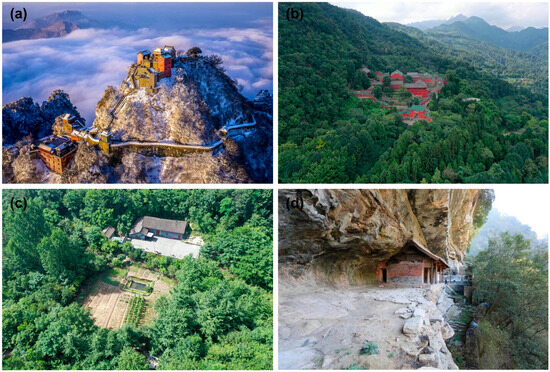
Figure 1.
Wudang Mountain temple complexes. (a) Palace-style temple; (b) Daoist temple; (c) small monastic temple; (d) cliffside temple.
Traditional narratives often emphasize that temple site selection in ancient China was guided by spiritual frameworks such as feng shui and imperial cosmology [6,7]. These principles extended beyond religious architecture to royal tombs and imperial capitals. For instance, the spatial layout of imperial mausoleums followed feng shui rules governing orientation and topographic alignment [8], while Ming dynasty capitals like Beijing were designed to reflect cosmic order and political hierarchy [9]. As a royal construction project, the Wudang Mountain temple complex was subject to particularly rigorous feng shui planning. Commissioned by Emperor Yongle, its layout reflected formalized Daoist cosmology and imperial ideology. Builders assessed topography, hydrology, orientation, and microclimate with precision, siting temples along ridges, gullies, or cliff faces to align with both natural forces and spiritual symbolism [10]. In this context, feng shui functioned not merely as a belief system, but as a codified environmental assessment tool. Its principles encompassed astronomy, geomorphology, hydrology, and climatology—integrating natural observations to determine the most auspicious and ecologically suitable locations [11]. The fusion of spiritual symbolism with ecological rationality in the Wudang complex reflects a sophisticated mode of landscape planning. Far from mystical speculation, feng shui may be reinterpreted as an early form of environmental science—what some modern scholars describe as “astroecology” or “landscape environmental science” [12]—grounded in empirical understanding of terrain, climate, and spatial order.
Despite the evident influence of natural factors, existing studies on famous mountain architecture largely focus on qualitative and symbolic interpretations [10,13], often treating the environment as a static backdrop rather than an active, measurable factor. This perspective limits our understanding of how environmental constraints have shaped temple siting. Bridging this gap requires the application of quantitative spatial approaches. Recent advances in GIS, remote sensing, and spatial statistics now allow for the integration of diverse environmental data to identify spatial distribution patterns and uncover underlying environmental drivers [14]. Analytical techniques such as kernel density estimation (KDE) [15], nearest neighbor index (NNI) [16], Moran’s I [17], and GeoDetector [18] are frequently employed to examine correlations between architectural distributions and environmental factors. GeoDetector is particularly effective in mountainous contexts with complex interactions among variables, as it accommodates non-linear relationships and compound effects. In addition, spatial statistical methods such as redundancy analysis, principal component analysis, and regression analysis [19] offer further tools for probing the influence of environmental drivers. Regression models complement GeoDetector by quantifying effect sizes and statistical significance, thereby deepening our understanding of the strength and directionality of influencing factors [20].
This research quantitatively examines how natural environmental factors shaped the spatial configuration and site selection of temple complexes in Wudang Mountain during the Ming Dynasty. It focuses on three core questions: (1) Do the temples exhibit clustered, linear, or random spatial patterns? (2) Which environmental variables are significantly associated with temple locations? (3) Do different temple types respond differently to environmental conditions? Integrating historical and architectural perspectives with spatial analysis, this research employs GIS-based modeling, GeoDetector, and regression analysis to examine diverse geospatial data. It explores the relationship between temple placement and environmental factors such as terrain, hydrology, climate, and soil. Beyond offering empirical evidence of site selection logic in ancient China, this research provides a practical framework for predicting lost sites and guiding heritage conservation. It also informs broader studies of mountain cultural landscapes, promoting data-driven, ecologically informed approaches to sustainable heritage management.
2. Materials and Methods
2.1. Research Area
Wudang Mountain is located in northwestern Hubei Province, China (32°24′–32°34′ N, 110°57′–111°15′ E), within the transitional zone between the Qinling–Dabie orogenic belt and the Yangtze Craton. Covering approximately 312 km2, it lies between the Han River to the northeast and the Danjiangkou Reservoir to the northwest, forming a key ecological and geological corridor between the North China Plain and the Sichuan Basin (see Figure 2).
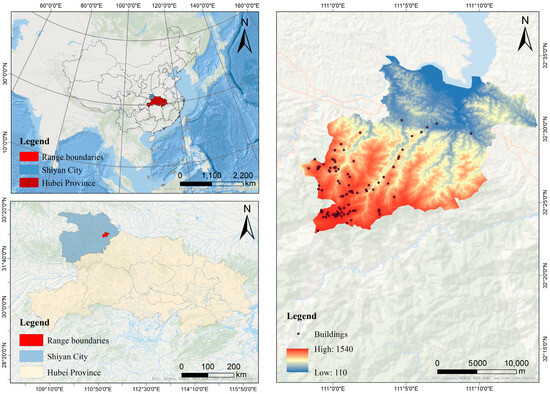
Figure 2.
Geographical location of Wudang Mountain scenic area. Spatial vector data were created using standard map basemaps downloaded from the Ministry of Natural Resources standard map service website (http://bzdt.ch.mnr.gov.cn (accessed on 1 May 2025)), with no modifications to the basemaps.
The Wudang Mountain temple complex originated during the Tang Dynasty and flourished during the Ming Dynasty, when successive emperors designated it as the primary site for royal ancestral worship. The complex includes various temple types, such as palace-style temples, Daoist temples, small monastic temples, and cliffside temples (see Table 1). This research draws on Ming Dynasty records, supported by mountain annals and local gazetteers, to identify 72 temples built during that period. The dataset includes temple names, locations, historical context, and structural details, forming the basis for a quantitative analysis of their spatial distribution and environmental adaptability.

Table 1.
Types and definitions of Wudang Mountain temple complexes.
2.2. Data Sources
2.2.1. Temple Location Data
This research employed a three-pronged strategy to accurately determine temple locations:
- (1)
- POI Data Extraction: Temple Points of Interest (POIs) were collected via the Gaode Map API and visualized in ArcGIS 10.7 (WGS-84 coordinate system). After data cleaning, deduplication, and coordinate calibration, a geospatial database was constructed. The boundary of Wudang Mountain was delineated by integrating official scenic area maps with Ming Dynasty cartographic sources.
- (2)
- Historical Document Mining: To address POI gaps and improve accuracy, temple names and spatial descriptions were extracted from Ming and Qing Mountain records and historical maps. These were georeferenced and cross-validated with known sites. Key sources included Taihe Wudang Mountain Topography [21], A Brief History of Mount Taihe [22], Distribution Map of the Palaces and Temples in Mount Taihe [23], Taihe Mountain Topography [24] and Wudang Mountain Chronicles [25], collectively forming a high-quality geospatial sample of historical architecture for spatial analysis.
- (3)
- Field and UAV Surveying: Fieldwork and UAV photogrammetry were used to verify POI data and refine locations, especially for cliffside temples situated on steep terrain. UAV-based 3D point cloud models were generated for 31 extant cliffside sites (see Figure 3). By integrating field measurements, textual evidence, and POI data, the research identified the precise locations of 72 Ming-era temples.
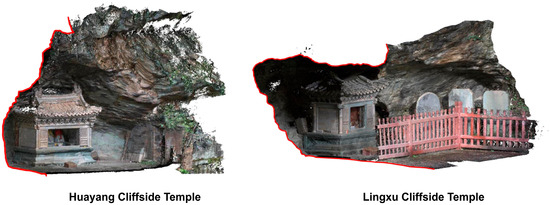 Figure 3. Field investigation and UAV photogrammetry were used to obtain geographic information and generate a point cloud model of the cliffside temple in Wudang Mountain.
Figure 3. Field investigation and UAV photogrammetry were used to obtain geographic information and generate a point cloud model of the cliffside temple in Wudang Mountain.
2.2.2. Natural Environment Data
To analyze the relationship between natural conditions and temple site selection, environmental variables were categorized into five domains: topography, hydrology, climate, vegetation, and soil (see Table 2). To ensure methodological rigor, the selection and quantification of the 13 environmental indicators were based entirely on objective geospatial datasets and standardized measurement procedures. All indicators were obtained from open-source, authoritative environmental databases and rasterized at consistent spatial resolutions to support spatial analysis.

Table 2.
Selection of influencing factors.
- (1)
- Topographic indicators—including altitude, aspect, slope, and landform type—were extracted from high-resolution Digital Elevation Model (DEM) data. Altitude and slope were calculated using surface gradient algorithms, while aspect was derived as a directional raster in degrees (0–360°), representing slope orientation, which influences solar radiation and microclimatic exposure. Landform types were classified through geomorphometric segmentation, dividing the terrain into categorical zones (e.g., ridges, valleys) using terrain partitioning algorithms.
- (2)
- Hydrological indicators—precipitation and distance from the nearest watershed—were obtained through interpolation of meteorological station data and hydrological network analysis, respectively.
- (3)
- Climate indicators—including average temperature, diffuse solar radiation, and direct solar radiation—were derived from multi-year meteorological raster datasets, ensuring temporal consistency with long-term climatic trends.
- (4)
- Vegetation was represented by NDVImax, the maximum normalized difference vegetation index during the typical growing season, derived from satellite imagery.
- (5)
- Soil indicators—including bulk density, porosity, and pH value—were extracted from regional soil databases and standardized for the 30–60 cm depth range to reflect subsoil properties relevant to structural foundation stability.
All data inputs were continuous variables, except for landform types, which were categorical. Specific values for each indicator were not subjectively assigned but were extracted from continuous raster layers using GIS spatial sampling techniques at the precise coordinates of each temple site. This ensured that the evaluation of each factor’s influence on temple distribution was based entirely on objective and reproducible spatial data. While we acknowledge that these proxies cannot fully capture historical environmental dynamics, they provide a valid approximation of ecological suitability patterns and support the study’s objective of identifying structural relationships between site selection and environmental factors. Data sources and acquisition methods are detailed in Table 3.

Table 3.
Description of the data in this paper.
2.3. Research Methods
2.3.1. Kernel Density Estimation
Kernel Density Estimation (KDE) is a spatial analysis technique that transforms discrete building coordinates into a continuous surface, revealing patterns of spatial clustering in heritage distributions [32,33,34]. Applied to the Wudang Mountain complex, KDE effectively highlights variations in density, spatial gradients, and polarization levels. The method is based on the Rosenblatt–Parzen function [18], as shown in Equation (1):
where denotes the kernel function, h denotes the search radius, denotes the distance from the estimated point to the observed point and denotes the amount of buildings in the scale range.
2.3.2. Nearest Neighbor Index
The nearest neighbor index (NNI) is used to assess whether the spatial distribution of point features is clustered, random, or uniform [35,36]. Uniform distributions yield the largest nearest-neighbor distances, random ones fall in the middle, and clustered patterns show the shortest distances [18]. By treating Wudang Mountain’s ancient buildings as spatial points, NNI effectively characterizes their distribution pattern. It is calculated as the ratio of the observed mean nearest-neighbor distance to the expected mean under random conditions [37], as shown in Equations (2) and (3):
where denotes the nearest neighbor index; represents the average distance between each point and its nearest neighbor; represents the theoretical nearest neighbor distance; A is the region’s area; is the number of points. If = l, the point feature distribution type is random; if > l, it is uniform; if < l, it is clustered.
2.3.3. Standard Deviation Ellipse
The standard deviation ellipse (SDE) is a spatial statistical method used to quantify the orientation, central tendency, and dispersion of geographic features [34]. Key parameters include the ellipse’s center, orientation angle, and the lengths of its major and minor axes. A higher axis ratio indicates strong directionality, while a lower ratio suggests more uniform dispersion [36]. Applied to the Wudang Mountain temple complex—particularly Daoist temples—SDE effectively visualizes distribution patterns and directional trends. The calculation formulas are presented in Equations (4) and (5):
where is the rotation angle; and represent the coordinate deviation values from the geometric center to the centroid of the region; and and represent the standard deviations of the ellipse along the x and y axes, respectively.
2.3.4. Buffer Analysis
Buffer analysis is used to assess the spatial characteristics of features within a defined radius [35]. In this research, it was applied to the river network of Wudang Mountain, abstracted as linear features. Buffer zones of varying widths were generated and overlaid with temple locations to quantify the number of buildings within each range. This approach helps analyze temple distribution patterns in relation to water proximity. The buffer size for a given point A is calculated using Equation (6):
where represents the radius of the buffer zone; is the Euclidean distance from planar point to ; denotes the buffer zone of feature .
2.3.5. Geographical Detector
GeoDetector is a statistical tool for identifying spatial differentiation and its driving factors without assuming linearity or being affected by multicollinearity [18,38]. In this research, it is used to explain the spatial distribution of temple complexes in Wudang Mountain. The interaction detector assesses whether pairs of environmental factors enhance explanatory power by comparing their individual q-values to the combined q-value [16]. A higher and significant q-value indicates stronger influence of the variable on spatial outcomes. The calculation is shown in Equation (7) [39]:
where the value measures the detection power of the independent variable within the range of [0, 1]. The closer its value is to 1, the greater the influence and stronger the effect of the factor on the spatial distribution of buildings. represents the stratification of the independent or dependent variable; is the amount of buildings in a certain subregion; is the variance of building density in a certain subregion; and , respectively, represent the total number of units and the variance of the whole.
Interaction q-values between variables (e.g.,) are calculated using the model’s built-in interaction detector, which assesses whether the combined influence of two variables is enhanced, is weakened, or remains independent. This q-value represents the explanatory power when the spatial stratifications of both variables are overlaid. The combined stratification is treated as a new composite variable, and the standard GeoDetector formula is applied to compute its q-statistic. To interpret the interaction results, the combined q-value is compared with the individual q-values of the two factors.
Independence: The two factors operate independently; combining them does not increase explanatory power, following Equation (8):
Bivariate Enhancement: The two factors together improve explanatory power beyond either one alone, following Equation (9):
Non-linear Enhancement: The combination yields a significantly stronger influence than the sum of the parts, indicating synergy or interaction beyond additive effects, following Equation (10):
Weakened Influence or Redundancy: The combined effect is weaker than either variable alone, possibly indicating spatial overlap or redundancy, following Equation (11):
2.3.6. Variable Correlation Analysis
- (1)
- Pearson Correlation Analysis
The Pearson correlation coefficient is a statistical measure used to assess the strength and direction of the linear relationship between two variables. The calculation formula is presented in Equation (12):
where and denote the observed values of the two variables, and and denote the mean values of the two variables.
- (2)
- Regression Analysis Models
This research primarily employs two types of regression models: linear regression and ridge regression. Linear regression is a statistical method used to predict a continuous response variable. Its objective function is defined in Equation (13). Ridge regression, an extension of linear regression, is designed to handle datasets with multiple covariates and multicollinearity. Its optimization objective is shown in Equation (14) [40]:
where is the i observation of the first eigenvalue of sample j, the first sample; is the first eigenvalue of the observation of the first sample; is the regression coefficient, denoting the independent variable , corresponding to the weights of the independent variables; and m is the sample size. represents the regularization parameter, which controls the strength of the penalty term. > 0 is the regularization parameter that controls the strength of the penalty. Larger values of shrink coefficients toward zero and reduce variance caused by multicollinearity.
3. Results
3.1. Spatial Distribution Characteristics
3.1.1. Overall Spatial Distribution Density
Kernel density analysis reveals that the spatial distribution of temples in Wudang Mountain can be classified into four levels: extremely high-, high-, medium-, and low-density, with an average density of 0.16 units/km2. Overall (see Figure 4a), the pattern is uneven and clustered, with a dense core in the southwest (dark red zone; 1.263–1.421) and a banded distribution extending northeast (0.473–1.055), reflecting a layout aligned with ridgelines, valleys, and ancient routes. This structure corresponds closely to the mountain’s topography, forming a spatial organization of linear extension. standard deviation ellipse (SDE) analysis confirms this southwest–northeast trend (orientation: 51°; axis ratio: 3.29), indicating strong directionality and clustering. The average observed distance between buildings (5837.04 m) is notably lower than the expected mean (6903.64 m), reinforcing the clustering pattern. In contrast, the northern and eastern edges (light yellow areas) show sparse distributions, with densities below 0.315, likely due to peripheral location and limited historical development. This spatial configuration follows a clear “sparse periphery—banded middle—dense core” structure. Clusters tend to occur in mountainous and plateau areas, while sparse zones lie in low river valleys prone to landslides and debris flows. Nearest neighbor index (NNI) analysis (see Figure 4b) further supports this pattern, with an average R-value of 0.721 (R < 1), statistically significant at the 0.01 level (z = −4.5205, p < 0.01), indicating a strong clustering tendency with 99% confidence.
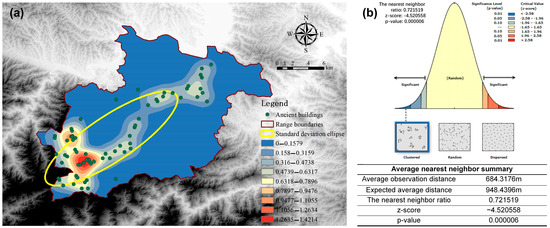
Figure 4.
(a) Kernel density analysis and mosque standard deviation ellipse; (b) mosque nearest neighbor index.
3.1.2. Spatial Distribution Type Characteristics
From the perspective of temple types, there are significant differences in their spatial distribution (see Figure 5). Small monastic temples are primarily concentrated in the northeastern and central regions, with the northeastern area forming a high-density core (average kernel density, KDM = 0.029). In contrast, high-density zones for palace-style temples, Daoist temples, and cliffside temples are all located in the southwestern region, with KDM values of 0.024, 0.037, and 0.070, respectively. Overall, all temple types exhibit uneven spatial clustering, though the degree of clustering varies among them.
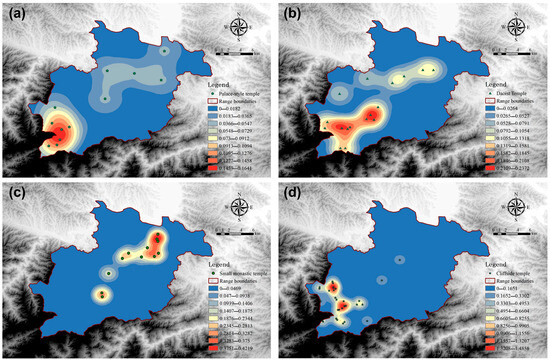
Figure 5.
(a) Palace-style temple kernel density analysis; (b) Daoist temple kernel density analysis; (c) small monastic temple kernel density analysis; (d) cliffside temple kernel density analysis.
3.2. Natural Environmental Factors Influencing the Spatial Distribution
3.2.1. Single-Factor Detection Results
- (1)
- Topography Factors
A 30 m resolution DEM was used to classify Wudang Mountain into five elevation zones (110–1540 m) using natural breaks (see Figure 6a). Terrain rises north to south, with most temples (27.78%) concentrated between 700 and 1000 m—an elevation offering favorable climatic, topographic, and symbolic conditions. Only 13.89% are in the highest zone (1000–1540 m), likely due to rugged terrain and harsher climates, resulting in a “concentrated middle, sparse ends” pattern. Slope analysis (0–58.9°, mean: 17.82°; Figure 6c) shows that temples favor moderate slopes (22–32°, 29.17%), avoiding flat (0–7°, 19.44%) and steep (32–59°, 9.72%) areas—reflecting preferences for drainage, visibility, and structural stability. Aspect analysis (see Figure 6b) reveals dominant southeast orientations (22.22%), followed by northwest and east orientations, aligning with traditional principles of “facing the sun and avoiding shadow” [34]. Temples are primarily located in “low elevation–moderate relief” (47.22%) and “mid elevation–high relief” (38.89%) zones (see Figure 6d), balancing construction feasibility with religious and scenic value. Overall, site selection reflects dual adaptation to environmental constraints and spiritual landscape esthetics.
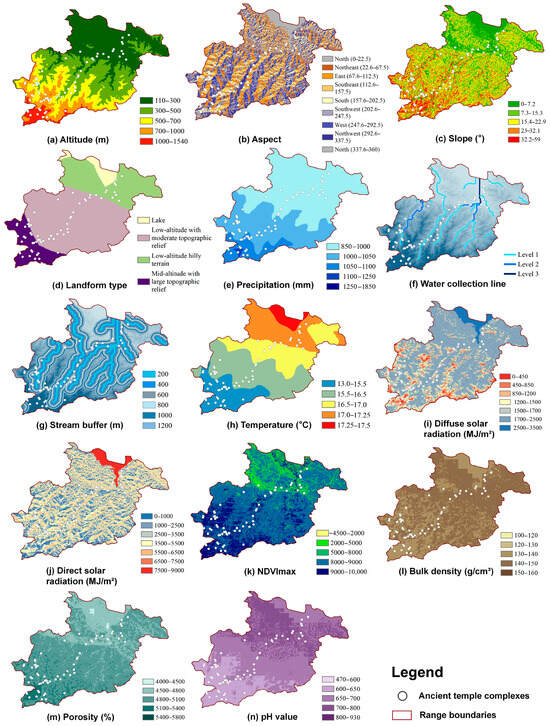
Figure 6.
Analysis of various natural factor indicators in GIS.
The parallel coordinates plot (see Figure 7) illustrates the temple site distribution across four key topographic variables: altitude, slope, aspect, and landform type. By identifying the densely packed areas in the parallel coordinates graph and the combinations with more repetitions in the legend (lines of the same color), it indicates that the location preference is stronger. The trajectories converge around mid-altitudes (700–1000 m), moderate slopes (7–22°), and south to southeast aspects in areas with pronounced relief—indicating consistent ecological preferences. Sparse representation in flat, low-altitude zones suggests avoidance of flood-prone or symbolically weak sites. These patterns point to intentional landscape optimization, prioritizing solar exposure, stability, and ritual alignment. The visualization supports the view that ancient temple siting applied early principles of terrain filtering for long-term ecological and cultural resilience—echoing modern sustainable land use strategies.
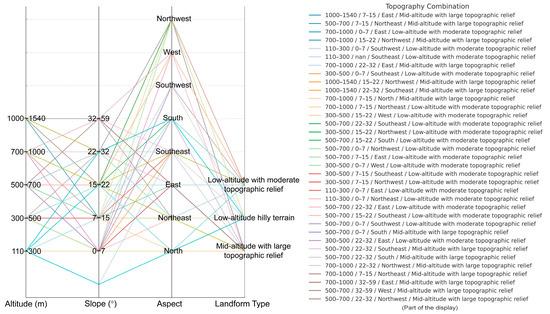
Figure 7.
Parallel coordinates plot illustrating temple site distribution across four topographic variables: altitude, slope, aspect, and landform type.
- (2)
- Hydrology Factors
Annual precipitation in Wudang Mountain ranges from 850 to 1850 mm, with most temples located in the 1000–1050 mm zone (37.50%), followed by 850–1000 mm and 1050–1100 mm (each 30.56%) (see Figure 6e). Despite abundant rainfall, steep slopes and narrow valleys create a seasonal watershed prone to flash floods, while mica-quartz schist bedrock limits groundwater availability [41]. ArcGIS buffer analysis of temple proximity to rivers (see Figure 6f,g) reveals clustering in the 200–400 m (16.67%) and 600–800 m (15.28%) zones—balancing water access and flood risk. Only 8.33% of temples lie within 200 m of rivers, and numbers decline sharply beyond 800 m.
Cross-analysis (see Figure 8) shows that temples concentrate in areas with 1050–1100 mm rainfall and >1200 m from rivers—indicative of optimal construction conditions. In contrast, high-rainfall zones (>1250 mm) or sites too close to rivers (<200 m) are sparsely occupied. This pattern reflects the principle of “near water, but not dependent on water,” emphasizing deliberate hydrological planning adapted to mountainous terrain.
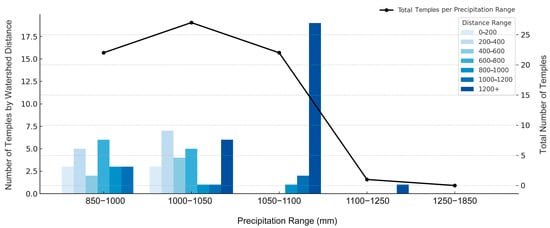
Figure 8.
Distribution of temple across precipitation and distance ranges.
- (3)
- Climate factors
To evaluate climate influence on temple siting, annual mean temperature in Wudang was divided into five intervals (13–17.5 °C; Figure 6h). The results show that 44.4% of temples lie within the 13–15.5 °C range, indicating a preference for thermally stable microclimates that minimize discomfort and material decay. For solar radiation, most temples fall within 1700–2500 MJ/m2 of diffuse radiation and 3500–5500 MJ/m2 of direct radiation (see Figure 6i,j), avoiding both low and high extremes—suggesting a preference for moderate light and thermal conditions.
To explore the climatic logic of temple siting, a parallel coordinates plot (see Figure 9) was constructed using categorized temperature, diffuse solar radiation, and direct solar radiation. The results show clear clustering in moderate-temperature zones (13–15.5 °C), mid-range diffuse radiation (1700–2500 MJ/m2), and high direct radiation (3500–5500 MJ/m2). The observed site selection preferences indicate a tendency toward areas characterized by relatively lower temperatures, higher levels of diffuse solar radiation, and moderate levels of direct radiation, while largely avoiding zones with extremely high direct solar exposure. Such lighting conditions are likely preferred for their capacity to provide stable, evenly distributed illumination rather than intense, fluctuating direct sunlight.
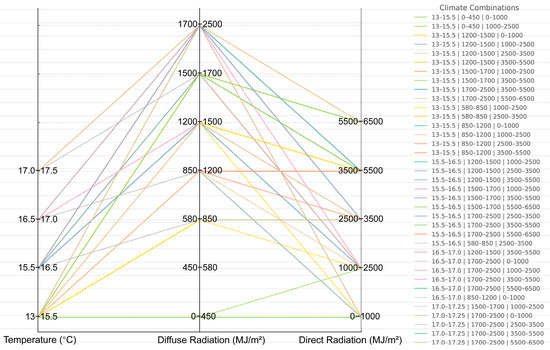
Figure 9.
Parallel coordinates plot illustrating the distribution of temple sites across three climatic factors: temperature, diffuse solar radiation, and direct solar radiation.
- (4)
- Vegetation factors
To examine the role of vegetation in temple site selection, NDVImax was divided into five intervals (see Figure 6k). As shown in Figure 10, temple density peaks in the 8000–9000 range, indicating a strong preference for densely vegetated areas. In contrast, temple presence drops sharply when NDVImax is below 5000, suggesting intentional avoidance of ecologically degraded zones. A slight decline above 9000 may reflect construction challenges in overly dense forests. Temple types show distinct ecological preferences. Cliffside temples cluster in areas with NDVImax >8000, favoring rugged, forested settings that align with their secluded and sacred character. Small monastic temples peak in the 8000–9000 range, balancing concealment and accessibility. Palace-style and Daoist temples are more evenly distributed above NDVImax 5000. These findings indicate that temple placement was ecologically informed and functionally differentiated. NDVImax, as a quantitative indicator, strengthens spatial heritage analysis and supports traditional Chinese ecological esthetics, such as “hiding from wind and gathering qi” and “dwelling among forests” [42].
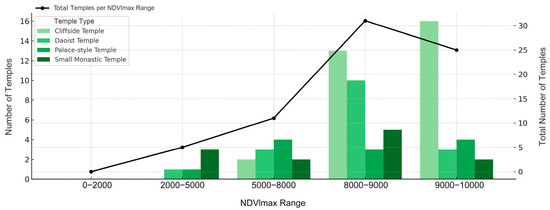
Figure 10.
Distribution of temple types across NDVlmax ranges.
- (5)
- Soil factors
Soil quality significantly influences site selection, with most Wudang temples built on yellow–brown soils. Analysis of bulk density (1.0–1.6 g/cm3; Figure 6l) shows that temples concentrate in the 1.4–1.5 g/cm3 range, favoring moderately compacted soils that ensure both stability and drainage. Porosity analysis (see Figure 6m) reveals peak distribution at 48–51%, while extremely low or high porosity correlates with sparse temple presence—indicating avoidance of soils prone to water retention or structural weakness. Most temples also lie in soils with a near-neutral pH (6.0–7.0; Figure 6n), with none in strongly acidic or alkaline zones, reflecting a preference for chemical stability and durability.
To examine the role of soil conditions in temple sitting, a parallel coordinates plot (see Figure 11) was created using bulk density, porosity, and pH. Site trajectories cluster within a narrow range for bulk density (1.4–1.5 g/cm3), porosity (48–51%), and pH (6.5–7.0)—reflecting optimal conditions for structural stability, drainage, and chemical balance. The absence of sites in soils with very low porosity (<45%) or extreme pH (<6.0 or >8.0) suggests an aversion to geotechnically marginal conditions. These patterns imply that ancient builders applied environmental heuristics—consciously or through tradition—to identify suitable soils. The findings underscore the relevance of edaphic factors in traditional sustainable construction and their importance in heritage conservation today.
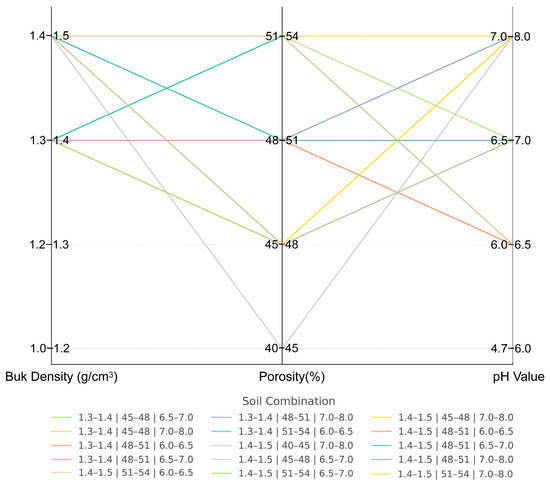
Figure 11.
Parallel coordinates plot illustrating temple site distribution across three soil variables: bulk density, porosity, and pH value.
3.2.2. Interaction Analysis of Influencing Factors
In this research, the kernel density of ancient buildings in Wudang Mountain was used as the dependent variable (Y), with 13 natural environmental factors (Xi) serving as independent variables to construct an evaluation index system for spatial distribution drivers. The variables include the following: altitude (X1), aspect (X2), slope (X3), landform types (X4), precipitation (X5), distance from watershed (X6), temperature (X7), diffuse (X8) and direct solar radiation (X9), NDVImax (X10), bulk density (X11), porosity (X12), and pH value (X13).
To evaluate the explanatory power of environmental variables on the spatial distribution of ancient buildings in Wudang Mountain, this study employed the GeoDetector model—a spatial statistical method used to assess the consistency between categorical explanatory factors and a continuous dependent variable. The analysis was conducted using the factor detector, which computes a q-statistic based on Equation (7). This q-value, ranging from 0 to 1, reflects the extent to which the spatial stratification of each variable explains the observed pattern of temple distribution. Near-zero or negative values indicate weak explanatory power or redundant influence.
Figure 12 presents the q-values, ranked as follows: q(X7) > q(X5) > q(X1) > q(X13) > q(X12) > q(X6) > q(X4) > q(X10) > q(X9) > q(X11) > q(X8) > q(X2) > q(X3). Temperature (X7) has the highest explanatory power (q = 0.430), reflecting a clear preference for warm, thermally stable environments. Precipitation (X5, q = 0.384) and altitude (X1, q = 0.306) follow, indicating the importance of water access and elevation—factors likely tied to ritual hierarchy, visibility, and defense. Soil pH (X13) and porosity (X12) show moderate influence, highlighting the role of chemical and hydrological soil conditions in foundation selection. In summary, temperature, precipitation, and elevation are the primary environmental drivers shaping temple distribution in Wudang Mountain.
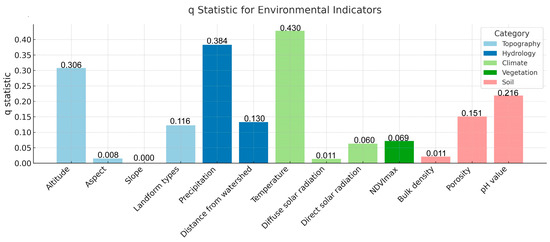
Figure 12.
The results of single factor analysis for temples distribution.
The interaction analysis reveals that the strongest interaction occurs between porosity and NDVImax (X12 × X11, q = 0.436), indicating that the interplay between soil structure and vegetation cover plays a critical role in shaping suitable microenvironments for temple construction (see Figure 13). Other notable high-interaction pairs include altitude × precipitation (X1 × X5, q = 0.399), and precipitation × bulk density (X5 × X13, q = 0.393), emphasizing the dominant influence of hydro-topographic and soil moisture conditions in site selection. Among all factors, precipitation (X5), altitude (X1), and porosity (X12) emerge as core environmental drivers frequently involved in strong synergistic interactions across domains. These variables form the foundation of a multidimensional filtering mechanism, reflecting deliberate considerations of water availability, terrain stability, and soil suitability by ancient builders. Overall, the results suggest that temple siting followed a multidimensional environmental filtering strategy, driven more by synergistic thresholds among variables than by any single factor alone.
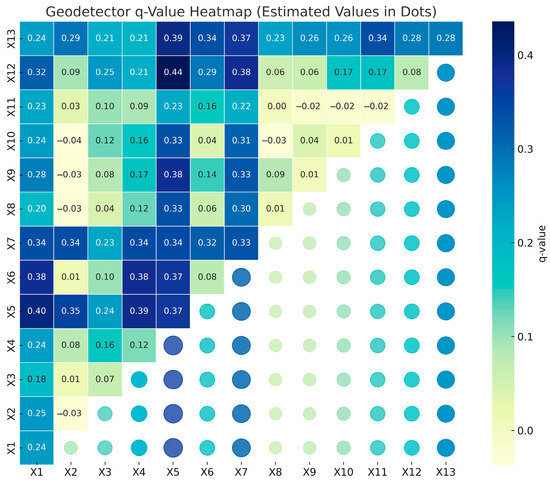
Figure 13.
The results of interaction factor analysis for temples distribution.
3.3. Natural Factors Shaping the Site Selection of Different Temple Types
To examine how different temple types respond to environmental factors, Pearson correlation analysis was conducted between four temple categories and 13 variables (see Table 4). Cliffside temples show the highest environmental sensitivity, favoring high elevations (r = 0.408, p < 0.001), steep slopes (r = 0.429, p < 0.001), high precipitation (r = 0.384, p < 0.01), and dense vegetation (NDVImax, r = 0.386, p < 0.01). They are negatively associated with soil pH (r = −0.507, p < 0.001) and landform complexity (r = −0.349, p < 0.01), indicating a preference for acidic, rugged terrain. Small monastic temples also display strong environmental associations but with opposite preferences—favoring lower elevations (r = −0.478, p < 0.001), warmer (r = 0.501, p < 0.001), and more humid settings (r = −0.489, p < 0.001), often near water (r = −0.270, p < 0.05). They prefer higher soil compaction (r = 0.353, p < 0.01) and a neutral to alkaline pH (r = 0.500, p < 0.001), and are positively linked to favorable landforms (r = 0.467, p < 0.001). While these relationships are statistically significant, we caution that they reflect associations rather than causal drivers.

Table 4.
Linear regression analysis of factors affecting the spatial distribution of four temple types.
In contrast, palace-style and Daoist temples show weak correlations with most variables. The former have a marginally negative association with slope (r = −0.215, p = 0.070), while the latter show a near-significant correlation with bulk density (r = 0.216, p = 0.069), suggesting their siting was more influenced by ritual or political factors than by environmental constraints. Overall, these results reveal clear ecological differentiation among temple types, reflecting functional roles and varying environmental dependencies in site selection.
To further investigate the environmental determinants of cliffside temple distribution, ridge regression was employed to model the effects of 13 continuous variables. This method is particularly well suited for dealing with multicollinearity—an issue present due to the topographic interdependence of variables like altitude, precipitation, and slope. The regularization parameter () was optimized using cross-validation to balance bias and variance. This approach stabilizes coefficient estimates and helps isolate the unique contribution of each variable. The regression results (Table 5) identify soil pH (standardized coefficient = −0.132, p = 0.013), porosity (−0.068, p = 0.026), and bulk density (−0.077, p = 0.034) as statistically significant predictors. All exhibit negative coefficients, suggesting that cliffside temples are more likely to be located in acidic, less porous, and less compacted soils. While the p-values indicate statistical reliability, their practical importance lies in what they reveal about terrain suitability: such soil properties are typically found in steep rock formations with minimal weathering—conditions structurally favorable for cliffside construction. Direct solar radiation, although not statistically significant (0.056, p = 0.130), shows a positive trend and may reflect a secondary influence—possibly related to thermal comfort or visual prominence. The model’s overall fit (R2 = 0.444; adjusted R2 = 0.308; F = 3.254, p < 0.01) confirms that geological and soil-related factors explain a meaningful portion of the variance in cliffside temple distribution. While this supports an ecological adaptation hypothesis, the results reflect probabilistic tendencies rather than deterministic causation. Site selection likely integrated both physical constraints and cultural–intentional criteria, including religious symbolism and visual prominence.

Table 5.
Results of ridge regression analysis for cliffside temple.
4. Discussion
4.1. Ecological Rationality in Temple Site Selection
The spatial configuration of temples in Wudang Mountain embodies an ecologically rational approach to site selection—balancing topographical suitability, climatic comfort, and cultural–symbolic meaning. Temple clusters align with the southwest–northeast ridgeline, forming a structured spatial structure. Kernel density and ellipse analyses reveal non-random clustering patterns centered on mid-elevation zones (700–1000 m), southeast-facing slopes (15–32°), and moderate proximity to rivers (200–800 m), consistent with traditional feng shui principles like “facing water and receiving sunlight” and “sheltering from wind to gather qi [15,34]”. These siting choices coincide with favorable environmental thresholds: precipitation between 1000 and 1100 mm, a diffuse radiation of 850–1500 MJ/m2, a direct radiation of 3500–6500 MJ/m2, and NDVImax values of 8000–9000—indicating preferences for moderate humidity and vegetation cover. Soil characteristics also reflect an ecological logic that temples predominantly occupy areas with a bulk density of 1.3–1.5 g/cm3 a porosity of 45–54%, and slightly acidic to neutral pH (6.5–7.0), conditions that ensure stable, well-drained, yet structurally sound foundations.
Variation in site preferences across temple types further supports this adaptive model. Cliffside temples, associated with seclusion and sanctity, cluster on high, steep, acidic, and vegetation-rich slopes. Ridge regression confirms soil pH, porosity, and bulk density as key predictors of their distribution (R2 = 0.444, p < 0.01). In contrast, Small monastic temples gravitate toward lower, warmer, high-pH zones with easier access to water and fertile soil, reflecting practical considerations. Palace-style and Daoist temples show weaker environmental associations, suggesting their placement was more ritualistic or politically motivated.
The evidence underscores an integrated, multi-scalar ecological strategy. From macro-level spatial organization to micro-siting decisions, temple builders leveraged topography, climate, and soil characteristics while preserving religious coherence. This reveals not only environmental awareness but also an embodied design logic rooted in the interaction between nature and culture. Although the statistical models support an ecological adaptation hypothesis, results indicate probabilistic associations rather than deterministic rules. Site selection likely involved both ecological constraints and cultural–intentional choices, including symbolic alignment, spiritual viewsheds, and ritual functions. Recognizing this dual logic—material and metaphysical—is key to understanding the sustainable spatial intelligence embedded in historical mountain landscapes [43,44].
4.2. The Influence of Cultural Factors in Temple Site Selection
While this study highlights the influence of natural environmental factors on temple site selection, the spatial organization of the Wudang Mountain complex cannot be fully understood without considering its cultural foundations. The site layout embodies a deliberate synthesis of ecological adaptability and cosmological symbolism—a defining feature of Ming dynasty imperial Daoism. Under Emperor Yongle, Wudang was not only revered as a sacred Daoist site but also instrumentalized as a stage for imperial legitimation. The complex was ritualized through a three-tiered spatial metaphor—“Human realm—Immortal realm—Heavenly realm”—mirroring Zhenwu’s ascension narrative [2] (see Figure 14). This conceptual hierarchy was mapped onto the mountain’s topography, with elevation symbolizing spiritual proximity: the higher the temple, the closer to divine authority [45]. For instance, the Golden Hall (Jindian) at Tianzhu Peak marked both the physical summit and the cosmological apex of celestial rule.

Figure 14.
An expanded cross-section of Wudang Mountain, reflecting the “heavenly sequence” in the construction culture of Wudang Mountain.
This symbolic logic worked in tandem with environmental strategies. Temples were typically placed on southeast-facing mid-slopes (700–1000 m elevation, 15–32° slopes) to optimize sunlight, thermal comfort, and wind protection—aligning with feng shui principles such as “sheltering from wind and accumulating qi [42].” Simultaneously, sacred geography guided the alignment along ridgelines, as confirmed by kernel density and standard deviation ellipse analyses, reinforcing symbolic orientation while ensuring structural soundness. This spatial ordering also echoed the triadic cosmological model of “Human realm—Immortal realm—Heavenly realm.” Different temple types reflected culturally embedded environmental preferences. Cliffside temples—often associated with spiritual isolation—were sited on steep, acidic, and densely vegetated slopes, favoring symbolic transcendence over physical comfort. In contrast, small monastic temples occupied lower elevations near water and fertile soil, better suited to daily ritual, agriculture, and community access. These distinctions illustrate how religious function and ecological reasoning jointly informed site selection at both macro and micro scales.
In essence, the Wudang temple network exemplifies an adaptive cultural–ecological system. Natural constraints—such as topography, solar exposure, hydrology, and soil conditions—defined feasible construction zones, while Daoist cosmology and imperial ideology shaped spatial hierarchy within them. This fusion produced a heritage landscape where environmental pragmatism and metaphysical symbolism were mutually reinforcing.
4.3. Research Limitations and Future Directions
This research has several limitations. There is a temporal mismatch between the Ming Dynasty construction period of the Wudang temples and the contemporary environmental datasets used in the analysis. In the absence of high-resolution paleoclimate reconstructions, historical vegetation records, and detailed soil archives, this study relied on modern environmental data as proxies, offering a static analysis rather than a dynamic portrayal of past conditions. While macro-scale topographic features (e.g., elevation, slope) are relatively stable over time, micro-environmental variables such as vegetation cover, soil characteristics, and local hydrology may have changed. To mitigate potential bias, we prioritized indicators with greater temporal resilience and used soil data from the 30–60 cm depth range to approximate subsurface conditions relevant to temple foundation stability. Although these constraints limit historical precision, the findings still offer meaningful insights into the ecological rationale underlying ancient site selection practices.
This research focuses specifically on the influence of natural environmental factors on the spatial distribution of temples in Wudang Mountain, aiming to clarify the ecological logic underlying site selection. While we fully acknowledge that cultural and religious factors—such as Daoist cosmology, imperial symbolism, and ritual spatial order—played a critical role, they were intentionally excluded from the GIS model to maintain methodological focus and isolate measurable environmental effects. This approach allows us to identify baseline ecological patterns without conflating them with symbolic meaning. We recognize this as a limitation and have included it in the discussion.
Future research should address these gaps through meeting the following objectives:
- (1)
- Historical Environmental Reconstruction: Incorporate paleoclimate records, historical vegetation data, and ancient soil profiles to better reflect the environmental conditions at the time of temple construction. This will reduce reliance on modern proxy datasets and improve temporal accuracy.
- (2)
- Dynamic Landscape Modeling: Integrate temporal GIS and landscape evolution modeling, as these can simulate environmental changes over time [46], offering a more dynamic understanding of how natural and cultural factors interacted during site selection.
- (3)
- Cultural–Spatial Interaction Analysis: Quantitatively examine how cosmological symbolism, political hierarchy, and religious ritual spaces influenced spatial logic, particularly in comparison with other sacred mountain sites.
5. Conclusions
This research quantitatively analyzed the spatial distribution and environmental adaptability of ancient temple complexes in the Wudang Mountains, providing robust evidence that traditional Chinese mountain temples were strategically sited with respect to multiple environmental factors. Using GIS, GeoDetector, and regression analysis, the research uncovered key patterns that demonstrate the ecological rationality underlying historical site planning. These findings shed new light on how ancient builders systematically incorporated terrain, climate, and soil conditions into spatial decision-making. The main conclusions are as follows:
- (1)
- The spatial layout of Wudang Mountain temples displays a clear hierarchical clustering pattern: dense cores in the southwestern highlands, ridge-aligned belts, and sparse peripheries. Kernel density and nearest neighbor analyses (R = 0.721, p < 0.01) confirm non-random agglomeration, while standard deviation ellipse analysis reveals a southwest–northeast orientation. This direction mirrors the natural balance that was struck in the Wudang range and aligns with historical pilgrimage routes, enhancing both sacred accessibility and visual prominence. These patterns reflect a deliberate balance between symbolic hierarchy and environmental suitability, with the mountain serving as an active agent in spatial planning.
- (2)
- Temple siting in Wudang Mountain reflects an integrated response to multiple environmental thresholds, particularly within the 700–1000 m elevation band. This range provides optimal conditions for visibility, climatic comfort, and symbolic prominence, while avoiding the extremes of lowland humidity and high-altitude exposure. The strongest interaction (porosity × NDVImax, q = 0.436) suggests that temples favored areas where moderately porous soils supported dense vegetation—enhancing slope stability and structural anchorage. Preferred soil conditions (porosity: 45–54%; bulk density: 1.3–1.5 g/cm3) strike a balance between load-bearing capacity and drainage efficiency. The prevalence of mildly acidic soils (pH 6.5–7.0), often associated with exposed bedrock, reflects a material adaptation strategy: such substrates resist biological degradation and provide long-term foundational integrity, particularly for cliffside temples.
- (3)
- The site selection of temple complexes in Wudang Mountain was shaped by the combined influence of multiple environmental variables, with no single factor independently determining suitability. Precipitation, altitude, and soil porosity emerged as key drivers, frequently involved in high-impact interactions. Cliffside temples exhibit the strongest ecological selectivity, favoring steep slopes, high elevations, acidic, low-porosity soils, and dense vegetation. Ridge regression confirmed soil pH, porosity, and bulk density as significant predictors (R2 = 0.444, p < 0.01), highlighting the importance of geotechnical and microclimatic stability in supporting this architectural form. In contrast, small monastic temples are concentrated at lower elevations with warmer temperatures, higher soil compaction, and high-pH soils near water sources—emphasizing accessibility and daily ritual use. Palace-style and Daoist temples show weaker environmental correlations, suggesting their siting was shaped more by symbolic, ritual, or political priorities than by ecological suitability. While these patterns support an ecological adaptation hypothesis, they reflect probabilistic tendencies rather than deterministic rules. Overall, temple siting reflects a synthesis of environmental constraints and intentional cultural selection.
Author Contributions
Y.Y.: writing—original draft, software, methodology, investigation, data curation, and conceptualization. Z.B.: writing—review and editing, software, and visualization. X.H.: investigation, data curation, and validation. Y.W.: supervision, supervision, project administration, funding acquisition. All authors have read and agreed to the published version of the manuscript.
Funding
This research was funded by National Natural Science Foundation of China, grant No.52278042.
Data Availability Statement
Data will be made available on request.
Conflicts of Interest
The authors declare no conflicts of interest.
References
- Wang, C.; Chen, M.; Wang, Y. Surface flaking mechanism of stone components of ancient building complex in Wudang Mountain, China. Constr. Build. Mater. 2023, 399, 132611. [Google Scholar] [CrossRef]
- Davis, N. Daoist Ritual, State Religion, and Popular Practices: Zhenwu Worship from Song to Ming (960–1644) by Shin-Yi Chao. J. Chin. Relig. 2012, 40, 100–103. [Google Scholar] [CrossRef]
- Jackson, P. Ideas in Daoism relative to ecology and the environment. In Nature, Environment and Culture in East Asia; Brill: Leiden, The Netherlands, 2013; pp. 41–68. [Google Scholar]
- von Erdberg-Consten, E. Time and Space in Chinese Cosmology. Philipp. Q. Cult. Soc. 1973, 1, 120–131. [Google Scholar]
- Zhu, Y. Contested sacred space: State power, spatial politics, and heritage tourism. Tour. Geogr. 2025, 1–25. [Google Scholar] [CrossRef]
- Magli, G. Sacred Landscapes of Imperial China: Astronomy, Feng Shui, and the Mandate of Heaven; Springer Nature: Berlin/Heidelberg, Germany, 2020. [Google Scholar]
- Xu, Z. Ancient Feng Shui View of Site Construction Site Selection and Layout Study. In Proceedings of the 2017 International Conference on Economics and Management, Education, Humanities and Social Sciences (EMEHSS 2017), Hangzhou, China, 15–16 April 2017; pp. 436–440. [Google Scholar]
- Cui, J.; Liu, Y.; Sun, J.; Hu, D.; He, H. Study on Feng Shui (Geomantic) suitability evaluation of mausoleums in Nanjing City Based on GIS. ISPRS Int. J. Geo-Inf. 2021, 10, 752. [Google Scholar] [CrossRef]
- Baratta, N.C.; Magli, G. The role of astronomy and Feng Shui in the planning of Ming Beijing. Nexus Netw. J. 2021, 23, 767–787. [Google Scholar] [CrossRef]
- Du, Y. Historic Research on Planning Theory and Methods of the Wudang Mountains Scenic Spot in Ming Dynasty. Ph.D. Thesis, Beijing Forestry University, Beijing, China, 2015. [Google Scholar]
- Mak, M.Y.; Ng, S.T. Feng shui: An alternative framework for complexity in design. Archit. Eng. Des. Manag. 2008, 4, 58–72. [Google Scholar] [CrossRef]
- Paton, M. Five Classics of Fengshui: Chinese Spiritual Geography in Historical and Environmental Perspective; Brill: Leiden, The Netherlands, 2013; Volume 110. [Google Scholar]
- Wang, J. Art Research of Scene Space on the Pilgrim’s Progress About Wu Dang Mountain. Ph.D. Thesis, Xi’an University of Architecture and Technology, Xi’an, China, 2012. [Google Scholar]
- Wei, G.; Han, G.-S.; Lang, X. Cultural heritage site selection characteristics and the impact of the natural environment in Jinan city, China. Sci. Rep. 2024, 14, 31038. [Google Scholar] [CrossRef]
- Gao, J.; Wang, J.; Wang, Q.; Cao, Y. Spatio-Temporal Distribution Characteristics of Buddhist Temples and Pagodas in the Liaoning Region, China. Buildings 2024, 14, 2765. [Google Scholar] [CrossRef]
- Ma, X.; Zhang, Y.; Li, Y.; Li, Y.; Lin, F. Spatial–temporal distribution and evolution of the socialist built heritage in China, 1949–1978. Herit. Sci. 2023, 11, 214. [Google Scholar] [CrossRef]
- Zhang, T.; Hu, Y.; Lei, T.; Hu, H. A GIS-based study on the spatial distribution and influencing factors of monastic gardens in Jiangxi Province, China. Front. Environ. Sci. 2023, 11, 1252231. [Google Scholar] [CrossRef]
- Liao, Y.; Cenci, J.; Zhang, J. Chinese modern architectural heritage resources: Perspectives of spatial distribution and influencing factors. ISPRS Int. J. Geo-Inf. 2023, 12, 358. [Google Scholar] [CrossRef]
- Kang, J.; Li, C.; Zhang, B.; Zhang, J.; Li, M.; Hu, Y. How do natural and human factors influence ecosystem services changing? A case study in two most developed regions of China. Ecol. Indic. 2023, 146, 109891. [Google Scholar] [CrossRef]
- Li, X. Determination of the temporal–spatial distribution patterns of ancient heritage sites in China and their influencing factors via GIS. Herit. Sci. 2024, 12, 143. [Google Scholar] [CrossRef]
- Wang, M. Taihe Wudang Mountain Topography. 1681. (In Chinese) [Google Scholar]
- Wang, G. A Brief History of Mount Taihe. 1744. (In Chinese) [Google Scholar]
- Fang, S. Distribution Map of the Palaces and Temples in Mount Taihe. 1536. (In Chinese) [Google Scholar]
- Fang, S.; Wang, Z.; Shen, G. Taihe Mountain Topography; Hubei Science and Technology Press: Wuhan, China, 2021. (In Chinese) [Google Scholar]
- Gao, K. Wudang Mountain Chronicles; Xinhua Publishing House: Beijing, China, 1994. (In Chinese) [Google Scholar]
- Geospatial Data Cloud, C.N.I.C., Chinese Academy of Sciences. Digital Altitude Model (DEM) Digital Altitude Data. 2025. Available online: https://www.gscloud.cn (accessed on 1 May 2025).
- Resources Environmental Science Data Center, C.A.o.S. Spatial Distribution Data of One Million Landform Types in China. 2024. Available online: https://www.resdc.cn/data.aspx?DATAID=124 (accessed on 1 May 2025).
- Shouzhang, P. 1-km Monthly Precipitation Dataset for China (1901–2023); National Tibetan Plateau Data Center: Beijing, China, 2024. [Google Scholar]
- Shouzhang, P. 1-km Monthly Maximum Temperature Dataset for China (1901–2023); National Tibetan Plateau Data Center: Beijing, China, 2024. [Google Scholar] [CrossRef]
- Dong, J.W.; Zhou, Y.; You, N.S. 30-Meter Annual Maximum NDVI Dataset of China from 2000 to 2022. 2021. Available online: https://www.nesdc.org.cn/sdo/detail?id=60f68d757e28174f0e7d8d49 (accessed on 1 May 2025).
- Shi, G.; Shangguan, W. A China Dataset of Soil Properties for Land Surface Modeling (Version 2, CSDLv2); National Tibetan Plateau/Third Pole Environment Data Center: Beijing, China, 2024. [Google Scholar] [CrossRef]
- Zhong, Z.; Peng, B.; Elahi, E. Spatial and temporal pattern evolution and influencing factors of energy–environmental efficiency: A case study of Yangtze River urban agglomeration in China. Energy Environ. 2021, 32, 242–261. [Google Scholar] [CrossRef]
- Liu, C.; Wang, H.; Song, L.; Fu, Q. Spatial Pattern and Influencing Factors of Hong Kong, Macao and Taiwan’s Direct Investment in the Pearl River-Xijiang River Economic Belt. DEStech Trans. Soc. Sci. Educ. Hum. Sci. 2018. [Google Scholar] [CrossRef]
- Xu, Z.; Tian, G.; Wei, K.; Ma, Y.; Zhang, S.; Huang, Y.; Yao, X. The influence of environment on the distribution characteristics of historical buildings in the Songshan Region. Land 2022, 11, 2094. [Google Scholar] [CrossRef]
- Huang, Y.; Xue, Q. Analysis of the Spatial Distribution Characteristics and Influencing Factors of Traditional Mosque Architecture in the Hehuang Area (China). Buildings 2024, 14, 1258. [Google Scholar] [CrossRef]
- Zhu, J.; Xu, W.; Xiao, Y.; Shi, J.; Hu, X.; Yan, B. Temporal and spatial patterns of traditional village distribution evolution in Xiangxi, China: Identifying multidimensional influential factors and conservation significance. Herit. Sci. 2023, 11, 261. [Google Scholar] [CrossRef]
- Gong, G.; Wei, Z.; Zhang, F.; Li, Y.; An, Y.; Yang, Q.; Wu, J.; Wang, L.; Yu, P. Analysis of the spatial distribution and influencing factors of China national forest villages. Environ. Monit. Assess. 2022, 194, 428. [Google Scholar] [CrossRef]
- Zhu, L.; Hu, J.; Xu, J.; Li, Y.; Liang, M. Spatial distribution characteristics and influencing factors of pro-poor tourism villages in China. Sustainability 2022, 14, 15953. [Google Scholar] [CrossRef]
- Chen, J.; Xu, C.; Lin, S.; Wu, Z.; Qiu, R.; Hu, X. Is there spatial dependence or spatial heterogeneity in the distribution of vegetation greening and browning in southeastern China? Forests 2022, 13, 840. [Google Scholar] [CrossRef]
- Shi, Y.; Mao, Y.; Zhou, L. Research on the Relationship between Public Open Space and the Thermal Environment in Shanghai Based on Multisource Data Integration. Sustain. Cities Soc. 2025, 106415. [Google Scholar] [CrossRef]
- Zhao, Y. Research on Landscape Character Identification for Famous Mountains Based on Integrity of Nature and Culture. Ph.D. Thesis, Huazhong Agricultural University, Wuhan, China, 2019. [Google Scholar]
- Parkes, G. Winds, waters, and earth energies: Fengshui and sense of place. In Nature Across Cultures: Views of Nature and the Environment in Non-Western Cultures; Springer: Berlin/Heidelberg, Germany, 2003; pp. 185–209. [Google Scholar]
- Wei, K.; Jiang, X.; Zhu, R.; Duan, X.; Yang, J. Spatial and Temporal Distribution Characteristics of Heritage Buildings in Yangzhou and Influencing Factors and Tourism Development Strategies. Buildings 2025, 15, 1081. [Google Scholar] [CrossRef]
- Van Nguyen, M.; Duy, K.H. Prioritizing barriers to the conservation of cultural heritage buildings in adaptation to urbanization and climate change. J. Clean. Prod. 2024, 473, 143529. [Google Scholar]
- Jia, J. Formation of the traditional Chinese state ritual system of sacrifice to mountain and water spirits. Religions 2021, 12, 319. [Google Scholar] [CrossRef]
- Chen, D.; Zhang, F.; Jim, C.Y.; Bahtebay, J. Spatio-temporal evolution of landscape patterns in an oasis city. Environ. Sci. Pollut. Res. 2023, 30, 3872–3886. [Google Scholar] [CrossRef]
Disclaimer/Publisher’s Note: The statements, opinions and data contained in all publications are solely those of the individual author(s) and contributor(s) and not of MDPI and/or the editor(s). MDPI and/or the editor(s) disclaim responsibility for any injury to people or property resulting from any ideas, methods, instructions or products referred to in the content. |
© 2025 by the authors. Licensee MDPI, Basel, Switzerland. This article is an open access article distributed under the terms and conditions of the Creative Commons Attribution (CC BY) license (https://creativecommons.org/licenses/by/4.0/).